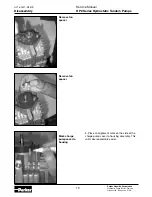
Service Manual
HP2 Series Hydrostatic Tandem Pumps
6
Parker Hannifi n Corporation
Hydraulic Pump/Motor Division
Greeneville, Tennessee USA
HY13-1521-M1/US
General Information
Hydraulic Components
If you think the problem is caused by a hydraulic com-
ponent, start by checking the easy-to-reach items.
Check all hoses and lines for cracks, hardening or
other signs of wear. Reroute any usable hoses that are
kinked, severely bent, or that rest against hot parts.
Look for leaks, especially at couplings and fi ttings.
Replace any hoses or lines that don’t meet system
fl ow and pressure ratings.
Next, go to the reservoir and fi lters. Check fl uid level
and look for air bubbles. Check the fi lter(s). A fi lter
with a maximum of 20 micron fi ltration is included for
the HP2 Tandem pump system.
Visually check other components to see if they are
loosely mounted, show signs of leaks, or other dam-
age or wear.
Excessive heat in a hydraulic system can create
problems that can easily be overlooked. Every system
has its limitation for the maximum amount of tempera-
ture. After the maximum temperature is attained and
passed, the following can occur:
• oil seal leaks
• pump loss of effi ciency (resulting in lower
transmission speeds)
• pump failure
• hoses become hard and brittle
• hose failure
A normal temperature range means an effi cient
hydraulic system. Consult the manuals published by
equipment and/or component manufacturers for maxi-
mum allowable temperatures and hydraulic tests that
may be necessary to run on the performance of the
hydraulic components. The HP2 Tandem pump is not
recommended for hydraulic systems with maximum
temperatures above 230° F (110° C).
Troubleshooting Guide
NOTE
Before troubleshooting any system problem,
check service literature published by the
equipment and/or component manufacturers.
Follow their instructions, if given, for checking
any component other than the HP2 Tandem
pump.
Preparation
Make your troubleshooting easier by preparing as
follows:
• work in a clean, well-lighted place
• have proper tools and materials nearby
• have an air pressure source.
WARNING
Since solvents are fl ammable, be ex-
tremely careful when using any solvent.
Even a small explosion could cause injury
or death.
WARNING
Wear eye protection and be sure to com-
ply with OSHA and other maximum air
pressure requirements.
Preliminary Checks
Hydraulic systems are often trouble-free. Hence, the
problem an operator complains of could be caused
by something other than the hydraulic components.
Thus, once you have determined that a problem ex-
ists, start with the easy-to-check items, such as:
• Parts damaged from impact that were not
properly repaired, or that should have been
replaced
• Improper replacement parts used in previ-
ous servicing
• Mechanical linkage problems such as bind-
ing, broken or loose parts, or slipping belts
6







































